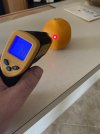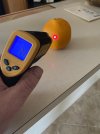I think we're talking about 1 barrel here. Sorry, no apples in the house. How about a grapefruit, an orange, and a wall? The orange was 1/10th of a degree lower. The point is, it's a reference and a pretty good one.
An IR temp sensor is inconsistent across different finishes and types of surfaces. Readings from bead-blasted and blued vs. polished and blued vs. bead-blasted SST vs. cerakote in any particular color will all be different when the metal's actual temperature is the same. Can use them to compare the same apple at different times. Can not use them to compare two different apples in any meaningful way. Forget about comparing an orange with one.

 An IR temp sensor is inconsistent across different finishes and types of surfaces. Readings from bead-blasted and blued vs. polished and blued vs. bead-blasted SST vs. cerakote in any particular color will all be different when the metal's actual temperature is the same. Can use them to compare the same apple at different times. Can not use them to compare two different apples in any meaningful way. Forget about comparing an orange with one.
An IR temp sensor is inconsistent across different finishes and types of surfaces. Readings from bead-blasted and blued vs. polished and blued vs. bead-blasted SST vs. cerakote in any particular color will all be different when the metal's actual temperature is the same. Can use them to compare the same apple at different times. Can not use them to compare two different apples in any meaningful way. Forget about comparing an orange with one.


